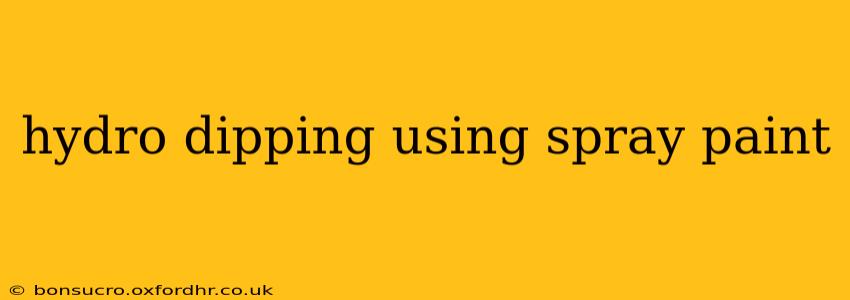Hydro dipping, also known as water transfer printing, is a fascinating technique that allows you to apply intricate designs to a variety of surfaces. While traditionally employing specialized hydrographic films, you can achieve surprisingly good results using spray paint. This guide will walk you through the process, providing tips and tricks for a successful hydro dipping project using spray paint.
Getting Started: Materials and Preparation
Before you dive in (pun intended!), gather your essential materials:
- Spray Paint: Choose high-quality acrylic lacquer spray paints in your desired colors. Multiple colors allow for more complex designs. Test your spray paint on a scrap piece of the same material you’ll be dipping to ensure compatibility and desired finish.
- Water Basin: A large, clean container (a plastic storage tub works well) to hold your water. The size depends on the size of the item you're dipping.
- Activator: This isn't strictly necessary with spray paint, but a slight activator like a dish soap solution can improve the paint's spread and help it float. Experiment to find the right balance. Too much soap can make the paint break up unevenly.
- Degreaser: Thoroughly clean your substrate with a degreaser to ensure the paint adheres properly. This is crucial for a long-lasting finish.
- Substrate: The item you wish to hydro dip. Ensure it's clean, dry, and free from any damage that could compromise the final finish. Plastics, wood, and metals often work well.
- Gloves and Eye Protection: Always prioritize safety! Wear gloves to protect your hands and eye protection to shield your eyes from spray paint and potential splashes.
- Paint Mixing Cups (Optional): If you're using multiple colors, separate cups make mixing and controlling the colors much easier.
- Rags or Paper Towels: For cleaning spills and wiping down surfaces.
The Hydro Dipping Process Using Spray Paint
This process differs slightly from traditional hydro dipping due to the paint's different behavior compared to hydrographic films.
1. Preparation is Key: Cleaning and Degreasing
Clean your substrate meticulously. Dirt, grease, or oils will prevent the paint from adhering correctly. Use a suitable degreaser, following the manufacturer's instructions. Allow it to dry completely.
2. Applying the Base Coat (Optional)
A base coat of primer or a solid color can create a more even and vibrant finish, especially on lighter-colored substrates. Let it dry completely before proceeding.
3. Creating the Paint Design on the Water Surface
This is where creativity comes in. Carefully spray your chosen paint colors onto the surface of the water. Experiment with different techniques:
- Layering: Spray light layers of different colors to create depth and complexity.
- Swirling: Gently swirl the paint with a stick or toothpick to blend and create unique patterns.
- Marbling: Use various colors and create marbled effects.
Important Considerations:
- Consistency: The paint shouldn't be too thick or too thin. Too thick will sink, too thin will spread too much and lose definition. Test spraying on a small amount of water first.
- Timing: Work quickly; the paint will begin to dry on the surface of the water.
4. Dipping the Substrate
Carefully lower your prepared substrate into the water, ensuring it makes full contact with the paint layer. Submerge it slowly and evenly to avoid creating ripples or disturbing the design. Keep it submerged for a few seconds before carefully lifting it out.
5. Drying and Finishing
Allow the item to air dry completely before handling. Once dry, you can apply a clear coat to protect the design and give it a glossy finish. Remember to let the clear coat dry thoroughly as well.
Troubleshooting and Tips for Success
- Uneven Coating: This usually points to insufficient cleaning or improper paint application.
- Paint Runs: Spray in thin, even coats from a consistent distance.
- Design Issues: Practice on water first to perfect your spray and swirling techniques.
Hydro dipping with spray paint requires practice and patience, but the rewarding results make it a worthwhile endeavor. Don't be discouraged by imperfections in your first attempts. The more you experiment, the better you'll become at controlling the paint and creating stunning designs. Remember to always prioritize safety by working in a well-ventilated area and using proper protective gear.
